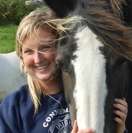Claire Brown
In 2008, Claire Brown was traveling through Ireland for an archaeological dig when she saw something that redirected her research track: ponies.
Connemara ponies, dotting pastures all over western Ireland. The ponies were bred, ridden and shown by a broad swath of Irish society: girls, middle-aged professionals, retired men in their 60s and 70s.
Brown switched her focus from archaeology to socio-cultural anthropology and began spending summers in Ireland. Now a doctoral candidate at Binghamton University, Brown received a National Science Foundation graduate research fellowship and is spending the 2014-15 academic year in Ireland working to understand how the Connemara pony parallels Irish culture.
"The pony is used, like a lot of things in Ireland, as a symbol of its modernity and its past," Brown says.
The Connemara was bred centuries ago as a stout farm worker, round-bodied and with strong legs to withstand sinking into a peat bog. The well-tempered, sure-footed work animal was perfect for an agrarian society, Brown says.
"People have said to me that Connemara ponies were tough because the people were tough," she adds.
After World War I, Ireland began to industrialize, and the breed morphed with it. Owners began to use the Connemara as a riding pony, rather than a work horse. The breed grew taller and more horse-like.
About 20 years ago, Ireland saw an economic boom that propelled it to the world stage as the "Celtic Tiger." Connemaras suddenly became show ponies. They grew popular, with 17 international breeding societies.
The Celtic Tiger collapsed in 2008, and Ireland went from one of the fastest-growing economies in the world to one of the hardest-hit. A people that had begun to re-define itself in a modern world had to sell the ponies that changed with it.
With new, international, expectations, the pony has begun to morph again, away from its working roots and into a sleeker, lighter pony. Not everyone in Ireland likes the change. "The pony that was kept strong scrambling around the hills of Connemara is now kept stabled," Brown notes.
"We don't realize how much the animals we have shape our lives," she says. "It's important when we try to understand people that we don't forget their animals."
Thomas Wilson, professor of anthropology at Binghamton, serves as Brown's adviser. "She is trying to tie aspects of the local cultural economy to the international economy," he says. "Scholars in the west of Ireland think she's onto a good thing."
The pony, like the culture, faces competing forces—international expectations vs. local tradition. The pony reflects Ireland's changing place in world culture, Wilson says: "Ireland is a lens in which to see the world."
And the Connemara pony, Brown says, "is integral to Irishness."
Provided by Binghamton University





















